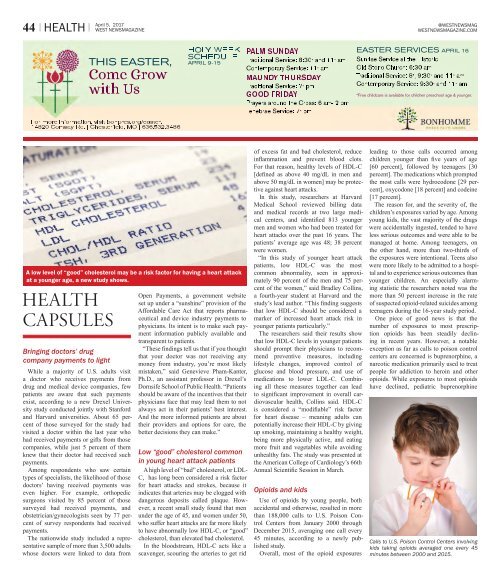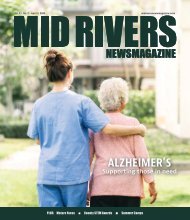West Newsmagazine 4-5-17
Local news, local politics and community events for West St. Louis County Missouri.
Local news, local politics and community events for West St. Louis County Missouri.
You also want an ePaper? Increase the reach of your titles
YUMPU automatically turns print PDFs into web optimized ePapers that Google loves.
44 I HEALTH I<br />
April 5, 20<strong>17</strong><br />
WEST NEWSMAGAZINE<br />
@WESTNEWSMAG<br />
WESTNEWSMAGAZINE.COM<br />
THIS EASTER,<br />
Come Grow<br />
with Us<br />
HOLY WEEK<br />
SCHEDULE<br />
APRIL 9-15<br />
PALM SUNDAY<br />
Traditional Service: 8:30* and 11* am<br />
Contemporary Service: 11* am<br />
MAUNDY THURSDAY<br />
Traditional Service: 7* pm<br />
GOOD FRIDAY<br />
Prayers around the Cross: 6 am- 2 pm<br />
Tenebrae Service: 7* pm<br />
EASTER SERVICES APRIL 16<br />
Sunrise Service at the Historic<br />
Old Stone Church: 6:30 am<br />
Traditional Service: 8*, 9:30* and 11* am<br />
Contemporary Service: 9:30* and 11* am<br />
*Free childcare is available for children preschool age & younger.<br />
For more information, visit bonpres.org/easter.<br />
14820 Conway Rd. | Chesterfield, MO | 636.532.3486<br />
A low level of “good” cholesterol may be a risk factor for having a heart attack<br />
at a younger age, a new study shows.<br />
health<br />
capsules<br />
Bringing doctors’ drug<br />
company payments to light<br />
While a majority of U.S. adults visit<br />
a doctor who receives payments from<br />
drug and medical device companies, few<br />
patients are aware that such payments<br />
exist, according to a new Drexel University<br />
study conducted jointly with Stanford<br />
and Harvard universities. About 65 percent<br />
of those surveyed for the study had<br />
visited a doctor within the last year who<br />
had received payments or gifts from those<br />
companies, while just 5 percent of them<br />
knew that their doctor had received such<br />
payments.<br />
Among respondents who saw certain<br />
types of specialists, the likelihood of those<br />
doctors’ having received payments was<br />
even higher. For example, orthopedic<br />
surgeons visited by 85 percent of those<br />
surveyed had received payments, and<br />
obstetrician/gynecologists seen by 77 percent<br />
of survey respondents had received<br />
payments.<br />
The nationwide study included a representative<br />
sample of more than 3,500 adults<br />
whose doctors were linked to data from<br />
Open Payments, a government website<br />
set up under a “sunshine” provision of the<br />
Affordable Care Act that reports pharmaceutical<br />
and device industry payments to<br />
physicians. Its intent is to make such payment<br />
information publicly available and<br />
transparent to patients.<br />
“These findings tell us that if you thought<br />
that your doctor was not receiving any<br />
money from industry, you’re most likely<br />
mistaken,” said Genevieve Pham-Kanter,<br />
Ph.D., an assistant professor in Drexel’s<br />
Dornsife School of Public Health. “Patients<br />
should be aware of the incentives that their<br />
physicians face that may lead them to not<br />
always act in their patients’ best interest.<br />
And the more informed patients are about<br />
their providers and options for care, the<br />
better decisions they can make.”<br />
Low “good” cholesterol common<br />
in young heart attack patients<br />
A high level of “bad” cholesterol, or LDL-<br />
C, has long been considered a risk factor<br />
for heart attacks and strokes, because it<br />
indicates that arteries may be clogged with<br />
dangerous deposits called plaque. However,<br />
a recent small study found that men<br />
under the age of 45, and women under 50,<br />
who suffer heart attacks are far more likely<br />
to have abnormally low HDL-C, or “good”<br />
cholesterol, than elevated bad cholesterol.<br />
In the bloodstream, HDL-C acts like a<br />
scavenger, scouring the arteries to get rid<br />
of excess fat and bad cholesterol, reduce<br />
inflammation and prevent blood clots.<br />
For that reason, healthy levels of HDL-C<br />
[defined as above 40 mg/dL in men and<br />
above 50 mg/dL in women] may be protective<br />
against heart attacks.<br />
In this study, researchers at Harvard<br />
Medical School reviewed billing data<br />
and medical records at two large medical<br />
centers, and identified 813 younger<br />
men and women who had been treated for<br />
heart attacks over the past 16 years. The<br />
patients’ average age was 48; 38 percent<br />
were women.<br />
“In this study of younger heart attack<br />
patients, low HDL-C was the most<br />
common abnormality, seen in approximately<br />
90 percent of the men and 75 percent<br />
of the women,” said Bradley Collins,<br />
a fourth-year student at Harvard and the<br />
study’s lead author. “This finding suggests<br />
that low HDL-C should be considered a<br />
marker of increased heart attack risk in<br />
younger patients particularly.”<br />
The researchers said their results show<br />
that low HDL-C levels in younger patients<br />
should prompt their physicians to recommend<br />
preventive measures, including<br />
lifestyle changes, improved control of<br />
glucose and blood pressure, and use of<br />
medications to lower LDL-C. Combining<br />
all these measures together can lead<br />
to significant improvement in overall cardiovascular<br />
health, Collins said. HDL-C<br />
is considered a “modifiable” risk factor<br />
for heart disease – meaning adults can<br />
potentially increase their HDL-C by giving<br />
up smoking, maintaining a healthy weight,<br />
being more physically active, and eating<br />
more fruit and vegetables while avoiding<br />
unhealthy fats. The study was presented at<br />
the American College of Cardiology’s 66th<br />
Annual Scientific Session in March.<br />
Opioids and kids<br />
Use of opioids by young people, both<br />
accidental and otherwise, resulted in more<br />
than 188,000 calls to U.S. Poison Control<br />
Centers from January 2000 through<br />
December 2015, averaging one call every<br />
45 minutes, according to a newly published<br />
study.<br />
Overall, most of the opioid exposures<br />
leading to those calls occurred among<br />
children younger than five years of age<br />
[60 percent], followed by teenagers [30<br />
percent]. The medications which prompted<br />
the most calls were hydrocodone [29 percent],<br />
oxycodone [18 percent] and codeine<br />
[<strong>17</strong> percent].<br />
The reason for, and the severity of, the<br />
children’s exposures varied by age. Among<br />
young kids, the vast majority of the drugs<br />
were accidentally ingested, tended to have<br />
less serious outcomes and were able to be<br />
managed at home. Among teenagers, on<br />
the other hand, more than two-thirds of<br />
the exposures were intentional. Teens also<br />
were more likely to be admitted to a hospital<br />
and to experience serious outcomes than<br />
younger children. An especially alarming<br />
statistic the researchers noted was the<br />
more than 50 percent increase in the rate<br />
of suspected opioid-related suicides among<br />
teenagers during the 16-year study period.<br />
One piece of good news is that the<br />
number of exposures to most prescription<br />
opioids has been steadily declining<br />
in recent years. However, a notable<br />
exception as far as calls to poison control<br />
centers are concerned is buprenorphine, a<br />
narcotic medication primarily used to treat<br />
people for addiction to heroin and other<br />
opioids. While exposures to most opioids<br />
have declined, pediatric buprenorphine<br />
Calls to U.S. Poison Control Centers involving<br />
kids taking opioids averaged one every 45<br />
minutes between 2000 and 2015.

















